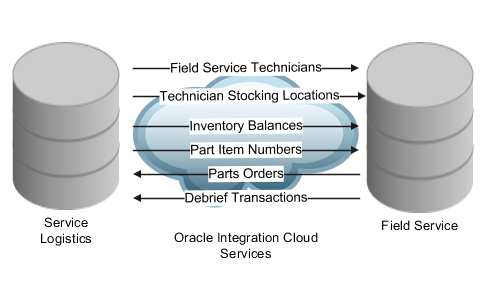Integration Component Architecture Between Service Logistics and Field Service
Service Logistics enables customers to optimize parts logistics, source and order service parts, record costs and invoice customers. Field Service offers time-based, self-learning, and predictive technology to dispatch field service technicians to resolve customer issues.
The Service Logistics to Field Service integration offers the following:
Field Service Technicians Download: Field Service Technicians are set up as Person Parties in Oracle Fusion Trading Community Model. A usage of Field Service Technician can be associated with a Person Party from several Oracle Cloud User Interfaces (UIs) including the Service Logistics Manage Field Service Technicians setup UI. An Integration Cloud Service is then performed to create the technician in Field Service if the technician doesn't exist or update the technician if they already exist.
Stocking Locations and Inventory Balances Download: Subinventories defined in Oracle Fusion Inventory Management can be set up as Stocking Locations in the Service Logistics Manage Stocking Locations setup UI. Once defined as Stocking Locations, these subinventories are assigned a type of Technician. Stocking Locations can then be assigned to technicians in the Service Logistics Manage Field Service Technicians setup UI. Stocking locations hold parts inventory that technicians use when fixing customer issues. An Integration Cloud Service is performed on a periodic basis that syncs stocking locations and their inventory balances from Inventory Management to Field Service.
Stocking Locations and Inventory Balances Incremental Download: Instead of loading all inventory balances, which can take a long time to complete, only those items transacted on the same day as the integration are loaded. This will be a smaller subset of all items and will run much faster. You should set up this integration to run multiple times a day and every day of the week.
Technician Inventory Balances Download: As an alternative to the Stocking Locations and Inventory Balances download, this integration will store the inventory balances directly on the technician resource instead of the truck resource. This is a more common approach among Oracle Field Service Cloud customers. Only inventory balances in the technician's default usable stocking location, as defined in Service Logistics, are synced. This integration should only be used if the technician is assigned to only one stocking location.
Technician Inventory Balances Incremental Download: Instead of loading all inventory balances, which can take a long time to complete, the only items loaded are those that have been transacted on the same day that you run the integration. This will be a smaller subset of all items and will run much faster. You should set up the integration to run multiple times a day and every day of the week. This integration should be used if the technician is assigned to only one stocking location.
Part Item Number Download: The Supply Chain Cloud parts catalog is downloaded to Oracle Field Service Cloud so that field service technicians know which parts can be ordered.
Parts Orders Integration: From Oracle Field Service Cloud, the technicians can order parts that are required for an activity or they can order parts to replenish their trunk stock. Service Logistics will source the parts and create the transfer orders. Parts orders for an activity will also be visible through the B2B Service work order.
Technician Receive Parts: This integration is a follow-up for the parts orders integration. It allows field service technicians to receive parts in Oracle Field Service Cloud, which were either ordered for an activity or used to replenish their trunk stock.
Preventive Maintenance Work Orders: For customer owned asset's preventive maintenance execution, you must convert the maintenance forecast results into service requests and work orders. You can schedule this integration to perform these tasks. Customers can configure different business rules to:
-
Retrieve the work order area from the Oracle Field Service Cloud setup.
-
Pass it as an input.
-
Generate the preventive maintenance work orders.
-
Labor hours recorded.
-
Parts used and recovered.
-
Expenses incurred on the activities assigned to them.
-
Review these debrief transactions.
-
Make any adjustments or corrections.
-
Post the debrief transaction.

Oracle Integration Cloud
The prebuilt integrations are available through Oracle Marketplace. You can log in and install the package directly into your Oracle Integration Cloud instance. The installation includes the following:
Connections
-
Connection: Service Logistics ESS
-
Connection: Service Logistics FA SOAP
-
Connection: Service Logistics OFSC
-
Connection: Service Logistics OFSC REST
-
Connection: Service Logistics Technician
-
Connection: Service Logistics Fusion REST
-
Connection: Service Logistics Locations
Integrations
-
Integration: Service Logistics Technician
-
Integration: Service Logistics Inventory
-
Integration: Service Logistics Inventory Incremental
-
Integration: Service Logistics Technician Inventory
-
Integration: Service Logistics Technician Inventory Incremental
-
Integration: Service Logistics Order Parts
-
Integration: Service Logistics Replenish Parts
-
Integration: Service Logistics Debrief
-
Integration: Service Logistics Receive Parts
-
Integration: Service Logistics Preventive Maintenance
-
Integration: Service Logistics Parts Catalog
To access the integrations in Oracle Marketplace, do the following:
-
Access Oracle Marketplace. In the Search field, enter criteria: Oracle Service Logistics Cloud to Oracle Field Service Cloud OIC recipe.
-
Click the "Oracle Service Logistics Cloud to Oracle Field Service Cloud OIC recipe" in the search results.
-
Click Get App.
-
Read and accept the Terms and click Next.
The My Oracle Support page Integrating Oracle Service Logistics Cloud with Oracle Field Service Cloud (Document ID 2481359.1) opens. This is where you can download the file.
For additional information, see the Integration Component Architecture Between Oracle Fusion Service and Oracle Field Service topic in the Integrating Fusion Service with Field Service guide.